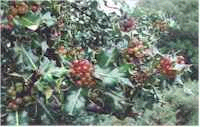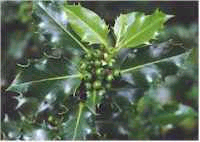
HOLLY 
FOLK NAMES: Aquifolius, Bat's Wings, Christ's thorns, Holy Tree, Holm Chaste, Hulm, Hulver Bush, Tinne GENDER: Masculine
PLANET: Mars
Element: Fire
POWERS:
Protection, Anti-Lightning, Luck and Dream Magick 
Holly is normally dioecious - which means it has separate male and female plants. The flowers are white and appear in summer. The ovary ripens in October to produce a bright red berry containing four 'nutlets' or seeds. In the wild trees start to produce berries when they are 20 years old. The berries are an important food source for many birds, such as thrushes, fieldfares, redwings and waxwings. If uneaten, the berries will stay on the tree until the following May. A good crop of berries is said to be a warning of a hard winter on the way but, in fact, a bumper berry crop is not a sign of bad weather to come but the result of a fine summer just past.

"Here comes the holly that is so noble!"
-Old Carol
At every summer's end, the Holly King fought and won a battle with the Oak King for the rulership of the year, and reigned supreme over the dark season. At the end of the winter, another battle was fought, this time won by the Oak King, who ruled triumphantly over the summer months. This ancient drama was enacted in the medieval romance of 'Gawain and the Green Knight,' where the giant Green Knight enters Arthur's court at the New Year bearing a great bush of holly as his insignia. He and one of Arthur's knights, Sir Gawain, whose name means the Hawk of May, engage in a beheading contest. Gawain, who as his name suggests, symbolizes the waxing year, strikes off the head of the Green Knight, but the Knight, who is magically still alive, will do the same to him next time around meaning, no doubt, at summer's end.
During the dark and barren days of winter, holly has always been prized for its fresh green leaves and bright berries, signifying the green of growth and fertility and the red or blood, a tree of hope and a reminder of the renewal of the springtime to come. The Romans used it in their winter celebrations known as the Saturnalia, and this custom may have spread to England.
Before the Christmas tree came to England in the nineteenth century, a great ball of evergreens and holly berries hung in cottage or hall, decorated with ribbons, paper roses, apples and oranges. It was called the kissing ball or kissing bunch, because a sprig of mistletoe hung down from it, inviting a lot of hopeful lurking beneath it.
It was important to bring in the right kind of holly at the right time. In Somerset, holly might not be brought in before Christmas Eve, and then only by a man. sterile holly was dangerous to man and beast, and on a year when holly had no berries, it was wise to add ivy or box to a wreath or ball for good luck. For the lack or berries could only point to infertility or death.
In some parts of England and Germany, hollys are referred to as "he" and "she", those with prickly-edged leaves being male, while the smooth-leafed variety signified a female tree. Whichever type was brought in determined whether the man or woman would rule the household in the coming year.
FOLKLORE Many a holly tree was spared the woodman's axe in days gone by because of a superstition that it was unlucky to cut one down. This belief probably arose because of the tree's evergreen leaves and long lasting berries, leaving people to associate holly with eternity and the power to ward off evil and destruction. Holly has long been a symbol of Yule and is often used to decorate houses at this time of year.
The colour red was used to ward off evil, witchcraft, the evil eye, demons and house goblins such as Robin Goodfellow, Brownie and Hobthrust. In Ireland the holly was called the "gentle tree" and the favourite tree of the fairies.
Leaves of a female holly would be placed under the pillow to foresee the future in dreams.
A parecellence protective herb. It was believed the Holly guards against lighning, poison and evil spirits. Planted around the home it protects it and its inhabitants from mischievous sorcerers. When thrown at wild animals, holly makes them lie down quietly and leave you alone, even if you don't hit them with the plant. Holly water ( infused or distilled) is sprinkled on newborn babies to protect them.
Holly is also carried to promote good luck, especially by men, since the holly is a "male plant", (Ivy is the corresponding plant for women). It is also hung around the house during Yule for luck.
After Midnight on a Friday, without making a sound, gather nine holly leaves, preferably from a non apiny plant. Wrap these in a white cloth using nine knots to tie the ends to tie the ends together. Place beneath your pillow and your dreams will come true.
Also like rowan. Holly protected against witchcraft. Scottish prisoners brought to Norfolk for draining the Fens stuck holly sprigs around the huts where they slept to keep witches away, probably because they could not find their native Rowan. But English people followed this custom, too. A stout holly stick was a good thing to have when walking home across the Fens on a dark night, and builders made cottage doorsteps of the wood so that witches could not enter. If you see an old holly hedge around a cottage, it may have been deliberately planted for the same reason.
In the north of England, holly was used for divination by dreams. In one ritual, leaves from a She holly were placed under the pillow for prophetic dreams. or a young girl might place three pails of water in their bedroom and pin three holly leaves at her heart before going to sleep on the eves of Christmas, New Years day, Midsummer, or Halloween. She expected to be roused by three yells, "as if from the throats of three bears", succeeded by as many hoarse laughs. When these died away, the form of her future husband appeared, and showed his future attachment to her by changing the position of the water pails. If he did not care for her, the water pails were found unchanged in the morning.
MEDICINAL PROPERTIES It was believed whooping cough could be cured by drinking milk out of a bowl made from the wood of the holly.
A tea made of holly leaves was given to promote sweating in cases of catarrh, pleurisy and smallpox, and to relieve fever and rheumatism. The berries caused violent sickness, but powdered they were used to stop bleeding. A substance called birdlime was made by fermenting young bark. Birdlime is a sticky substance used for catching birds. It was also used as an insect repellent in hot countries. It was also used in folk magic for physical illness. In Hampshire, children with whooping cough drank out of a cup made from holly-wood.
An old remedy for worms consisted of placing holly and sage in a bowl of water. When the patient yawned over the bowl, the worm was supposed to fall out into the water. And it was also used as a flagellant to cure chilblains.
Yule Fire Spell ******
On the darkest night of the year, gather together three dried leaves of holly and pulverize them into powder. On a clean, four-inch by four-inch piece of parchment paper, write a single word in red ink that represents what quality or trait you would like to be born within yourself along with the newborn Yule Sun. Sprinkle the holly powder into the center of the paper and twist the whole thing closed with the holly powder inside. Light
the wick of a red candle, and from this flame, light the holly-filled paper on fire. As it burns, see your wish fulfilled. The spell is done.

Holly was often paired with ivy, whose black berries symbolized night and darkness. In some regions, holly played the king and ivy his queen as in the old Somerset carol:
"O the Ivy O, she's the Queen of old,
And the Holly he is red.
Hang 'en high in the farm, and us won't come to no harm Till the Christmas days be told."
Of all the trees that are in the wood,
The holly bears the crown.
After Christmas, the holly still had an important part to play. On Hogmanay in the Scottish Highlands, boys whipped each other with its prickly boughs - for good luck! For each drop of blood drawn from this painful rite meant a year of good health and prosperity. In some places, Christmas holly had to be burned at Twelfth Night, or ill-luck would follow. Another old custom ruled that it should stay up until Shrove Tuesday, and yet another, that it must be kept until the following year to protect the house from Lightning. In Scotland, Candlemas Eve (February 1st) was the proper time, before the old festival of Brigid welcomed in the returning light. In Robert Herrick's carol 'Candlemas Eve,' holly is replaced by new greenery:
Down with the rosemary and bays,
Down with the mistletoe;
Instead of holly, now upraise
The greener box, for show. The foliage was often burned in a ceremonial manner. In the Lake District, an annual procession took place called the "Carrying of the Holling or Holly tree." The tree was lit and was carried aloft through the town, followed by people bearing torches and flaming branches, while others set off rockets and squibs.

|




